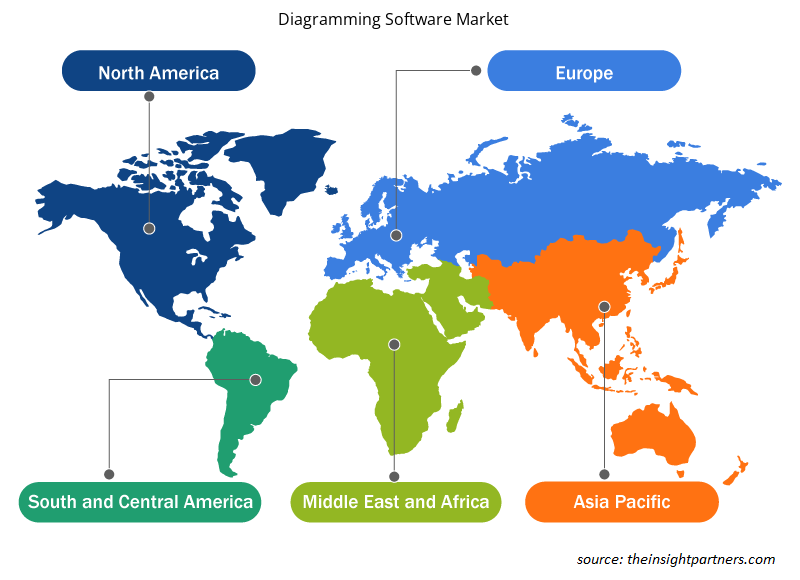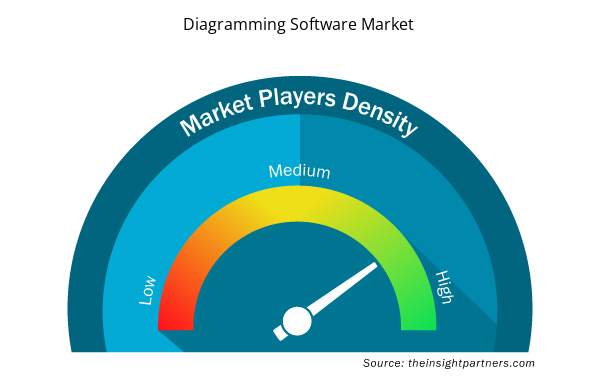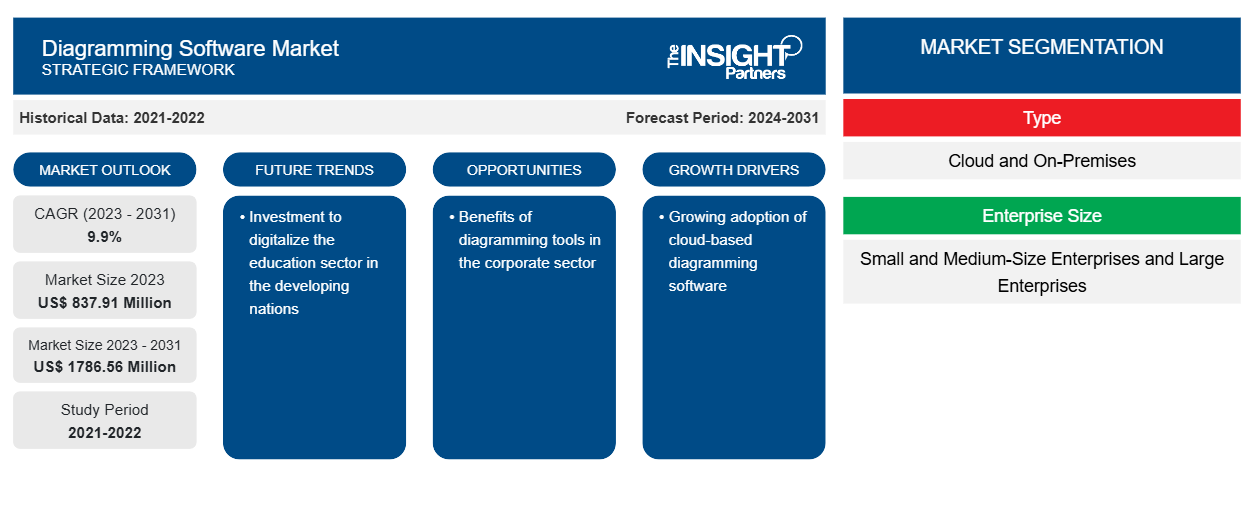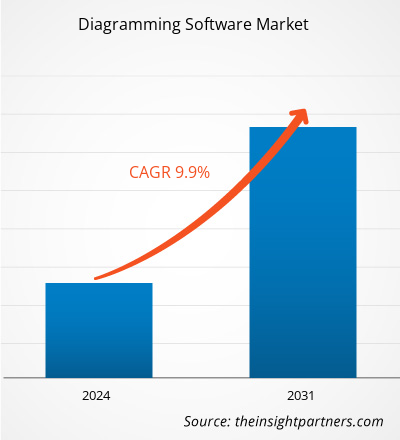ダイアグラム作成ソフトウェアの市場規模は、2023 年の 8 億 3,791 万米ドルから 2031 年には 1 億 7,8656 万米ドルに達すると予測されています。市場は 2023 年から 2031 年にかけて 9.9% の CAGR を記録すると予想されています。デジタル化の進展とクラウドベースのダイアグラム作成ソフトウェアの採用拡大は、今後も市場の主要なトレンドであり続けると思われます。
ダイアグラム作成ソフトウェア市場分析
大企業や中小企業での導入が増えているため、ダイアグラム作成ソフトウェア市場は勢いを増しています。このソフトウェアを導入することで、ビジネス環境におけるワークフローと操作をより適切に定義できるようになります。マーケティング、人事、エンジニアリング、運用など、組織のさまざまな部門で幅広く使用できます。
ダイアグラム作成ソフトウェア市場の概要
ダイアグラム作成ソフトウェアを使用すると、データセットや画像に基づいて、フローチャート、円グラフ、フロアプラン、その他の図を含む詳細なダイアグラムを作成できます。ダイアグラム作成ソフトウェアには、ユーザーが最初からダイアグラムを作成するのに役立つさまざまなテンプレートが含まれています。このソフトウェアは、他のツールやプラットフォームと簡単に統合でき、複数のユーザーがダイアグラムを表示して作成に参加できます。
要件に合わせてレポートをカスタマイズする
このレポートの一部、国レベルの分析、Excelデータパックなど、あらゆるレポートを無料でカスタマイズできます。また、スタートアップや大学向けのお得なオファーや割引もご利用いただけます。
- このレポートの主要な市場動向を入手してください。この無料サンプルには、市場動向から見積もりや予測に至るまでのデータ分析が含まれます。
ダイアグラム作成ソフトウェア市場の推進要因と機会
企業部門におけるダイアグラム作成ツールの利点
図はコミュニケーションの複雑さを軽減するのに役立ちます。ビジネス環境では、図はビジネス プロセスを明確かつ簡潔に視覚的に表現します。これは、プロジェクトの実装で従う必要のある目標とプロセスに関して、すべての従業員の理解に役立ちます。図作成ツールを導入することで、チーム リーダーまたはプロジェクト マネージャーは、図を使用して説明しながら、プロジェクトのワークフローを従業員に提供できます。図作成ソフトウェアは、円グラフ、フロー チャート、およびその他のいくつかのテンプレート化された図を作成するのに役立ちます。プロジェクトまたはビジネス目標を視覚的に表現することで、従業員はプロジェクトの傾向と範囲をよりよく理解できます。そのため、企業は図作成ソフトウェアを広く導入しています。
クラウドベースのソフトウェアの導入
先進国と発展途上国の両方で工業化とグローバル化の取り組みが進んでいるため、すべての業界でビジネス活動が拡大しています。さらに、企業が競争上の優位性を獲得し、生産性を最大化するためにデジタル変革を採用していることが観察されています。このため、企業はコスト効率の高いソリューションを求めており、クラウドベースのダイアグラム作成ソフトウェアソリューションの採用につながっています。
ダイアグラム作成ソフトウェア市場レポートのセグメンテーション分析
ダイアグラム作成ソフトウェア市場分析の導出に貢献した主要なセグメントは、展開タイプ、企業規模、およびアプリケーションです。
- 展開タイプに基づいて、ダイアグラム作成ソフトウェア市場はクラウドとオンプレミスに分かれています。オンプレミスセグメントは2023年に市場で最大のシェアを占めました。
- 企業規模別に見ると、市場は中小企業と大企業に分かれています。中小企業セグメントは最も高い CAGR で成長すると予想されています。
- 企業規模別に見ると、市場は教育機関、法人、および個人に分類されます。教育機関セグメントは、2023 年に市場の大きなシェアを占めました。
地域別のダイアグラム作成ソフトウェア市場シェア分析
ダイアグラム作成ソフトウェア市場レポートの地理的範囲は、主に北米、アジア太平洋、ヨーロッパ、中東およびアフリカ、南米および中米の 5 つの地域に分かれています。
アジア太平洋地域は最大の市場シェアを占めており、最高の CAGR で成長すると予想されています。インド、日本、中国などの国がアジア太平洋市場のシェアの大部分を占めています。デジタル化の進展は、デジタル ソリューションの採用につながる主な要因の 1 つです。e ラーニング プラットフォームの拡大と発展途上国における中小企業の増加が、ダイアグラム作成ソフトウェア ソリューションの採用を促進しています。
ダイアグラム作成ソフトウェア市場の地域別分析
予測期間を通じてダイアグラム作成ソフトウェア市場に影響を与える地域的な傾向と要因は、Insight Partners のアナリストによって徹底的に説明されています。このセクションでは、北米、ヨーロッパ、アジア太平洋、中東およびアフリカ、南米および中米にわたるダイアグラム作成ソフトウェア市場のセグメントと地理についても説明します。

- ダイアグラム作成ソフトウェア市場の地域別データを入手
ダイアグラム作成ソフトウェア市場レポートの範囲
| レポート属性 | 詳細 |
|---|---|
| 2023年の市場規模 | 8億3,791万米ドル |
| 2031年までの市場規模 | 17億8,656万米ドル |
| 世界のCAGR(2023年~2031年) | 9.9% |
| 履歴データ | 2021-2022 |
| 予測期間 | 2024-2031 |
| 対象セグメント | タイプ別
|
| 対象地域と国 | 北米
|
| 市場リーダーと主要企業プロフィール |
|
ソフトウェア市場のプレーヤー密度の図解:ビジネスダイナミクスへの影響を理解する
ダイアグラム作成ソフトウェア市場は、消費者の嗜好の変化、技術の進歩、製品の利点に対する認識の高まりなどの要因により、エンドユーザーの需要が高まり、急速に成長しています。需要が高まるにつれて、企業は提供内容を拡大し、消費者のニーズを満たすために革新し、新たなトレンドを活用し、市場の成長をさらに促進しています。
市場プレーヤー密度とは、特定の市場または業界内で活動している企業または会社の分布を指します。これは、特定の市場スペースに、その市場規模または総市場価値に対してどれだけの競合相手 (市場プレーヤー) が存在するかを示します。
ダイアグラム作成ソフトウェア市場で事業を展開している主要企業は次のとおりです。
- クリエイティヴ
- ドロー.io
- Gliffy の Perforce
- エドローソフト
- ルシチャート
- マイクロソフト
免責事項:上記の企業は、特定の順序でランク付けされていません。

- ダイアグラム作成ソフトウェア市場のトップキープレーヤーの概要を入手
ダイアグラム作成ソフトウェア市場のニュースと最近の動向
ダイアグラム作成ソフトウェア市場は、主要な企業出版物、協会データ、データベースなどの一次調査と二次調査後の定性的および定量的データを収集することによって評価されます。ダイアグラム作成ソフトウェア市場におけるいくつかの開発を次に示します。
- Google は、まったく新しい Google Cloud アーキテクチャ ダイアグラム ツールをリリースしました。このツールを使用すると、ユーザーはチームとビジョンを共有し、チームと連携して設計を繰り返し、ビジネス ユースケースの要件に最適な最終バージョンを作成できます。(出典: Google、プレスリリース、2022 年 2 月)
- 大手ダイアグラム作成ソフトウェアの EdrawMax は、ユーザーがプロフェッショナルなフローチャートやブロック図を簡単に作成できるモバイル版 EdrawMax アプリをリリースしました。生産性を向上させ、ユーザーの時間を節約するこの新しいアプリは、ユーザーがカスタマイズや変更して洗練されたダイアグラムを作成できる 20,000 を超える高品質のダイアグラム テンプレートを提供します。(出典: PRNewswire、プレスリリース、2023 年 4 月)
ダイアグラム作成ソフトウェア市場レポートの対象範囲と成果物
「ダイアグラム作成ソフトウェア市場の規模と予測(2021〜2031年)」レポートでは、以下の分野をカバーする市場の詳細な分析を提供しています。
- 対象範囲に含まれるすべての主要市場セグメントについて、世界、地域、国レベルでソフトウェア市場の規模と予測を図式化します。
- ソフトウェア市場の動向、および推進要因、制約、主要な機会などの市場動向を図式化する
- 詳細なPEST/ポーターの5つの力とSWOT分析
- 主要な市場動向、世界および地域の枠組み、主要プレーヤー、規制、最近の市場動向を網羅した図表ソフトウェア市場分析
- 市場集中、ヒートマップ分析、主要プレーヤー、ダイアグラム作成ソフトウェア市場の最近の動向を網羅した業界の状況と競争分析
- 詳細な企業プロフィール
- 過去2年間の分析、基準年、CAGRによる予測(7年間)
- PEST分析とSWOT分析
- 市場規模価値/数量 - 世界、地域、国
- 業界と競争環境
- Excel データセット



Report Coverage
Revenue forecast, Company Analysis, Industry landscape, Growth factors, and Trends

Segment Covered
This text is related
to segments covered.

Regional Scope
North America, Europe, Asia Pacific, Middle East & Africa, South & Central America

Country Scope
This text is related
to country scope.
よくある質問
The estimated value of the diagramming software market will be US$ 1786.56 million by 2031.
Creately, draw.io, Gliffy by Perforce, Edrawsoft, Lucidchart, Microsoft, FigJam, MyDraw, NULAB, and SmartDraw are some of the key players operating in the diagramming software market.
Investment to digitalize the education sector in developing nations is considered a key trend in the diagramming software market.
The rise in digitalization and growing adoption of cloud-based diagramming software are the key driving factors impacting the diagramming software market.
The global diagramming software market is estimated to register a CAGR of 9.9% during the forecast period 2023–2031.
Trends and growth analysis reports related to Technology, Media and Telecommunications : READ MORE..
The Insight Partners performs research in 4 major stages: Data Collection & Secondary Research, Primary Research, Data Analysis and Data Triangulation & Final Review.
- Data Collection and Secondary Research:
As a market research and consulting firm operating from a decade, we have published and advised several client across the globe. First step for any study will start with an assessment of currently available data and insights from existing reports. Further, historical and current market information is collected from Investor Presentations, Annual Reports, SEC Filings, etc., and other information related to company’s performance and market positioning are gathered from Paid Databases (Factiva, Hoovers, and Reuters) and various other publications available in public domain.
Several associations trade associates, technical forums, institutes, societies and organization are accessed to gain technical as well as market related insights through their publications such as research papers, blogs and press releases related to the studies are referred to get cues about the market. Further, white papers, journals, magazines, and other news articles published in last 3 years are scrutinized and analyzed to understand the current market trends.
- Primary Research:
The primarily interview analysis comprise of data obtained from industry participants interview and answers to survey questions gathered by in-house primary team.
For primary research, interviews are conducted with industry experts/CEOs/Marketing Managers/VPs/Subject Matter Experts from both demand and supply side to get a 360-degree view of the market. The primary team conducts several interviews based on the complexity of the markets to understand the various market trends and dynamics which makes research more credible and precise.
A typical research interview fulfils the following functions:
- Provides first-hand information on the market size, market trends, growth trends, competitive landscape, and outlook
- Validates and strengthens in-house secondary research findings
- Develops the analysis team’s expertise and market understanding
Primary research involves email interactions and telephone interviews for each market, category, segment, and sub-segment across geographies. The participants who typically take part in such a process include, but are not limited to:
- Industry participants: VPs, business development managers, market intelligence managers and national sales managers
- Outside experts: Valuation experts, research analysts and key opinion leaders specializing in the electronics and semiconductor industry.
Below is the breakup of our primary respondents by company, designation, and region:

Once we receive the confirmation from primary research sources or primary respondents, we finalize the base year market estimation and forecast the data as per the macroeconomic and microeconomic factors assessed during data collection.
- Data Analysis:
Once data is validated through both secondary as well as primary respondents, we finalize the market estimations by hypothesis formulation and factor analysis at regional and country level.
- Macro-Economic Factor Analysis:
We analyse macroeconomic indicators such the gross domestic product (GDP), increase in the demand for goods and services across industries, technological advancement, regional economic growth, governmental policies, the influence of COVID-19, PEST analysis, and other aspects. This analysis aids in setting benchmarks for various nations/regions and approximating market splits. Additionally, the general trend of the aforementioned components aid in determining the market's development possibilities.
- Country Level Data:
Various factors that are especially aligned to the country are taken into account to determine the market size for a certain area and country, including the presence of vendors, such as headquarters and offices, the country's GDP, demand patterns, and industry growth. To comprehend the market dynamics for the nation, a number of growth variables, inhibitors, application areas, and current market trends are researched. The aforementioned elements aid in determining the country's overall market's growth potential.
- Company Profile:
The “Table of Contents” is formulated by listing and analyzing more than 25 - 30 companies operating in the market ecosystem across geographies. However, we profile only 10 companies as a standard practice in our syndicate reports. These 10 companies comprise leading, emerging, and regional players. Nonetheless, our analysis is not restricted to the 10 listed companies, we also analyze other companies present in the market to develop a holistic view and understand the prevailing trends. The “Company Profiles” section in the report covers key facts, business description, products & services, financial information, SWOT analysis, and key developments. The financial information presented is extracted from the annual reports and official documents of the publicly listed companies. Upon collecting the information for the sections of respective companies, we verify them via various primary sources and then compile the data in respective company profiles. The company level information helps us in deriving the base number as well as in forecasting the market size.
- Developing Base Number:
Aggregation of sales statistics (2020-2022) and macro-economic factor, and other secondary and primary research insights are utilized to arrive at base number and related market shares for 2022. The data gaps are identified in this step and relevant market data is analyzed, collected from paid primary interviews or databases. On finalizing the base year market size, forecasts are developed on the basis of macro-economic, industry and market growth factors and company level analysis.
- Data Triangulation and Final Review:
The market findings and base year market size calculations are validated from supply as well as demand side. Demand side validations are based on macro-economic factor analysis and benchmarks for respective regions and countries. In case of supply side validations, revenues of major companies are estimated (in case not available) based on industry benchmark, approximate number of employees, product portfolio, and primary interviews revenues are gathered. Further revenue from target product/service segment is assessed to avoid overshooting of market statistics. In case of heavy deviations between supply and demand side values, all thes steps are repeated to achieve synchronization.
We follow an iterative model, wherein we share our research findings with Subject Matter Experts (SME’s) and Key Opinion Leaders (KOLs) until consensus view of the market is not formulated – this model negates any drastic deviation in the opinions of experts. Only validated and universally acceptable research findings are quoted in our reports.
We have important check points that we use to validate our research findings – which we call – data triangulation, where we validate the information, we generate from secondary sources with primary interviews and then we re-validate with our internal data bases and Subject matter experts. This comprehensive model enables us to deliver high quality, reliable data in shortest possible time.


 このレポートの無料サンプルを入手する
このレポートの無料サンプルを入手する